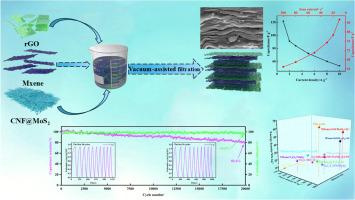High-performance MXene/reduced graphene oxide/carbon nanofibers@MoS2 composite films for flexible asymmetric supercapacitors
IF 5.6
3区 材料科学
Q1 ELECTROCHEMISTRY
引用次数: 0
Abstract
Electrode materials for supercapacitors often suffer from limitations such as restricted ion accessibility, suboptimal cycling stability, and inadequate electrical conductivity, which compromise their electrochemical performance and practical utility. To overcome these challenges, strategic incorporation of intercalation materials to enhance ion transport and active site availability presents a viable approach. In this study, we used MoS2 coated carbon nanofibers (CNFs) and reduced graphene oxide (rGO) nanosheets as intercalation agents to construct a strong 3D interlayer framework within MXene nanosheets and prepared MXene/rGO/CNF@MoS2 composite films by vacuum-assisted filtration. The designed architecture notably enlarged the interlayer distance, facilitated rapid ion diffusion, and enhanced the availability of electroactive sites. The resulting film exhibited an exceptional specific capacitance of 1015 F g-1 at 1 A g-1. Additionally, an asymmetric supercapacitor (ASC) was constructed with the composite film as the positive electrode and activated carbon (AC) as the negative electrode, delivering a broad operating voltage of 1.5 V and a capacitance of 212.7 F-1 at 1 A g-1. The device reached an impressive energy density of 66.45 Wh kg-1 at 750 W kg-1, while retaining 80.4% of its capacitance over 20,000 charge-discharge cycles at 5 A g-1, confirming outstanding long-term stability. This work demonstrates a scalable and effective strategy to enhance MXene-based electrodes, offering great potential for high-performance, flexible energy storage systems.


柔性非对称超级电容器用高性能MXene/还原氧化石墨烯/碳nanofibers@MoS2复合薄膜
超级电容器电极材料通常存在离子可及性受限、循环稳定性欠佳、电导率不足等问题,影响了其电化学性能和实际应用。为了克服这些挑战,战略性地结合插入材料来增强离子传输和活性位点的可用性是一种可行的方法。在本研究中,我们使用MoS2包覆的碳纳米纤维(CNFs)和还原氧化石墨烯(rGO)纳米片作为插层剂,在MXene纳米片内构建了一个强大的三维层间框架,并通过真空辅助过滤制备了MXene/rGO/CNF@MoS2复合薄膜。设计的结构显著地扩大了层间距离,促进了离子的快速扩散,并提高了电活性位点的可用性。所得薄膜在1 A g-1时表现出1015 F -1的特殊比电容。此外,以复合膜为正极,活性炭(AC)为负极构建了非对称超级电容器(ASC),其工作电压为1.5 V,在1 a g-1下的电容为212.7 F-1。该器件在750 W kg-1时达到了令人印象深刻的66.45 Wh kg-1的能量密度,同时在5 A g-1的20,000次充放电循环中保持了80.4%的电容,证实了出色的长期稳定性。这项工作展示了一种可扩展和有效的策略来增强基于mxene的电极,为高性能,灵活的储能系统提供了巨大的潜力。
本文章由计算机程序翻译,如有差异,请以英文原文为准。
求助全文
约1分钟内获得全文
求助全文
来源期刊

Electrochimica Acta
工程技术-电化学
CiteScore
11.30
自引率
6.10%
发文量
1634
审稿时长
41 days
期刊介绍:
Electrochimica Acta is an international journal. It is intended for the publication of both original work and reviews in the field of electrochemistry. Electrochemistry should be interpreted to mean any of the research fields covered by the Divisions of the International Society of Electrochemistry listed below, as well as emerging scientific domains covered by ISE New Topics Committee.
 求助内容:
求助内容: 应助结果提醒方式:
应助结果提醒方式:


